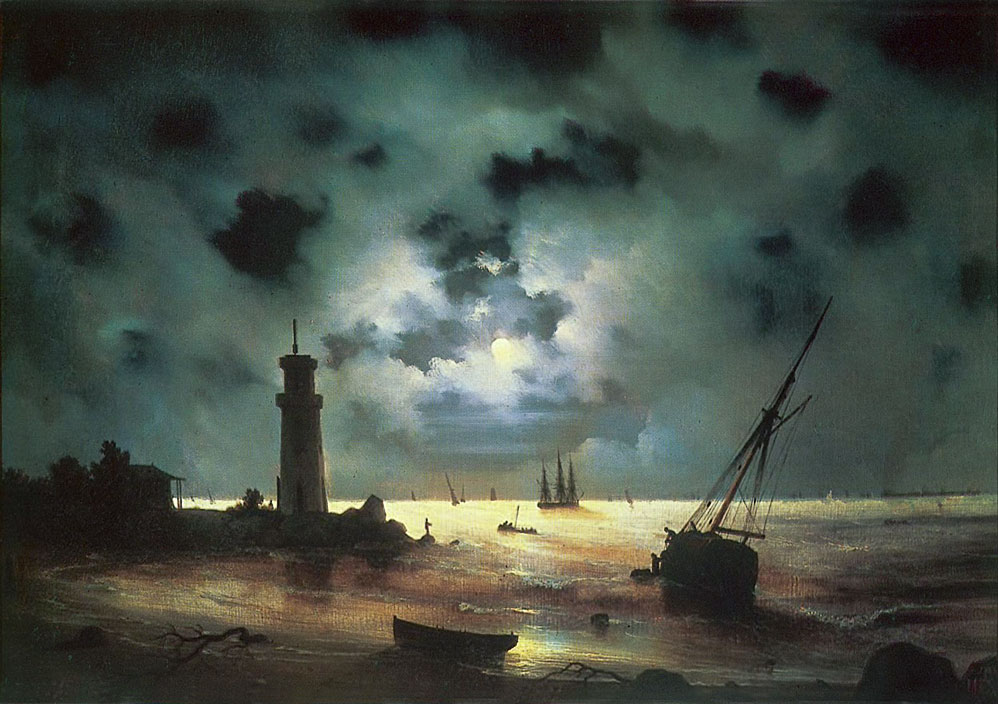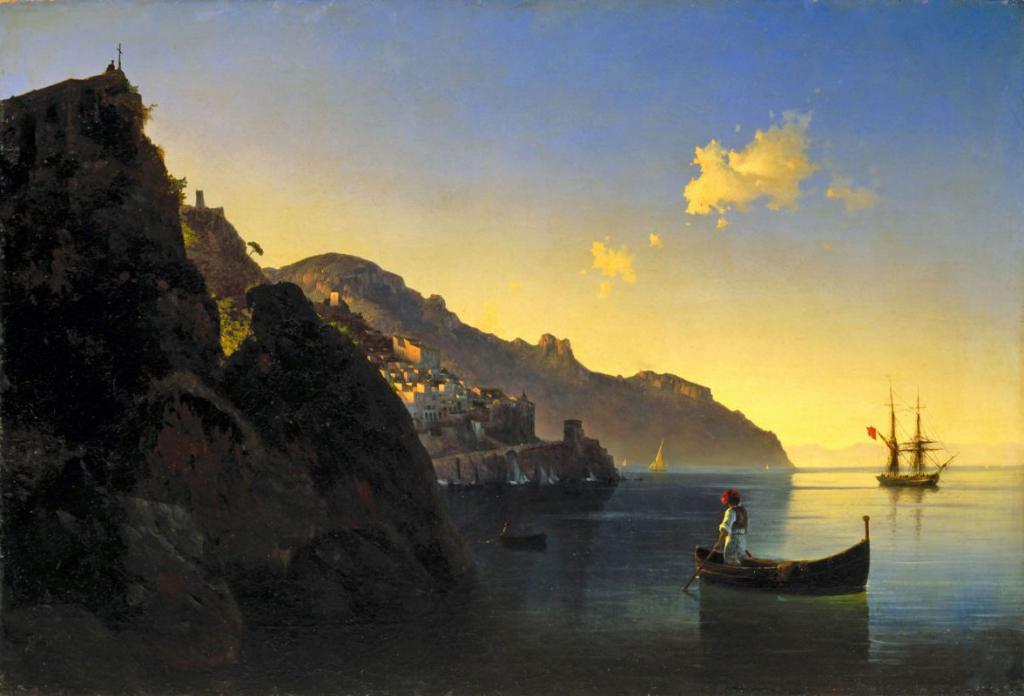Often Aivazovsky is called a minion of fate. This is not surprising - popularity came to him in his youth and remained with the artist until the last days of his life, and his paintings were always very warmly received by the public. Aivazovsky is among those artists that even people who are far from fine art know about and whose work is liked by the absolute majority. Aivazovsky owes this success, of course, to his unique talent: he is often called the "singer of the sea." Indeed, the artist devoted his whole life and all his creativity to this element, in an infinite number of paintings each time opening it in a new way. Below is a short story about the biography and work of Aivazovsky, interesting facts and performance features that formed the unique style of the marine painter.
Biography. Childhood
Hovhannes Ayvazyan - this is the real name of the artist - was born July 17 (29), 1817 in the ancient Crimean city of Feodosia in the family of the impoverished merchant Gevork (Konstantin) Ayvazyan. Gevork wrote his last name in the Polish manner - Gayvazovsky. Their family barely made ends meet, and Hovhannes, the youngest son, began to earn money already from the age of ten.
The boy's talent manifested itself very early. Ayvazyanov’s house stood on the outskirts of the city, on a hill, from where an unusual view of the sea opened. The susceptibility of the future artist allowed him to absorb all the beauty of the endless sea element in order to later embody it in his immortal canvases.
But even then, Hovhannes already drew. Thanks to the happy occasion, with which the biography and work of Aivazovsky abound (which invariably accompanied success only during life), his drawings were noticed by the mayor of Treasurers. He praised the boy’s abilities and took an ardent part in his fate. Treasurers presented him with paints and paper for drawing and trained with the city architect, then sent to Simferopol to the gymnasium. There, in Simferopol, Ayvazyan’s talent was also noticed, and it was decided to work on his enrollment in the St. Petersburg Academy of Arts.
The president of the Academy in those years was Olenin, a well-known patron of the arts, who did a lot for Russian culture. Having examined the extraordinary talent in Ayvazyan, he decides to appoint a 13-year-old boy to the Academy.
Studying at the Academy of Arts
At the Academy, Hovhannes Ayvazyan (he will change this name to “Ivan Aivazovsky” a little later, in 1841) ended up in a landscape class with M.N. Vorobyov, one of the most famous painters of the early 19th century. Vorobyov became famous not only for his paintings, but also to a large extent for a whole galaxy of famous artists whom he brought up (and Aivazovsky - among them). Vorobyov immediately noticed the tendency of his student to the sea, and then he supported and developed it in every way. He himself was one of the best landscape painters of his time, and Aivazovsky took and mastered much of his individual traits of skill. This is felt well in the painting "The seashore at night. At the lighthouse" (1837).

While studying at the Academy, Aivazovsky also actively gets acquainted with works of art collected in the Hermitage and private collections. Then he participated in the Academic exhibition with two canvases: "Study of air over the sea", his first painting, and "View of the seaside in the vicinity of St. Petersburg."
Trip to Crimea
In the spring of 1838, Aivazovsky, by decision of the Academy Council, was sent to Crimea for two years to improve his skills. Naturally, the artist chooses Theodosius, the city in which he spent his childhood, as the place of his stay. There he writes a lot from life: he creates sketches, small sketches.
There, Aivazovsky painted his first major painting from life: "Yalta" (1838). In this picture, the influence of another famous Russian landscape painter, Sylvester Shchedrin, is noticeable , however , it was in the Crimea that the artist's original style begins to take shape. This is more noticeable in the film "Old Theodosius" (1839). In the canvases created on the Crimean coast, the artist seeks to create an image of a particular place, to capture the unique, characteristic features of the place.
In 1839, at the invitation of Raevsky, Aivazovsky went on a naval campaign to the shores of the Caucasus. According to the impressions left from that trip, later he will write "Landing N. N. Raevsky at Subasha" (1839).
In 1840, Aivazovsky returned to St. Petersburg, where he officially completed his studies and was awarded the title of artist.
Italy
In the summer of 1840, Aivazovsky as a boarder of the Academy, among others, went to Rome to improve his skills. There he travels a lot, doing countless sketches, sketches, later modifying them in the workshop. Here, the artist’s creative method finally takes shape: an amazing sensitivity to the elusive shades of the state of the elements, the ability to memorize a picture in detail, and then refine sketches in the workshop based on what he saw. He created many canvases without sketching from nature, from memory.

In Italy, in three years, he creates, in addition to other paintings, more than 30 large-format canvases - the performance is truly extraordinary. These are the views of Naples, Venice, Amalfi, Sorento. But, besides them, there are also truly monumental works: “Creation of the World. Chaos” - the largest of all that he created in Italy. All the artist's works are distinguished by an impeccable color composition, sustained in a single and style and perfectly conveying all the nuances of the mood of the landscape.
Later, he will repeatedly return to Italian landscapes, creating new canvases from the workshop already from memory.
North seas
Aivazovsky returned to his homeland as a world-famous artist. He was awarded the title of academician, and also ranked among the Main Naval Headquarters. Immediately there appears a voluminous and complex task: to write all the Russian sea ports on the Baltic Sea. So a large series of paintings appears, among which are the views of Krondstat, Revel, Sveaborg. All of them combine documentary accuracy in conveying details and at the same time poetic spirituality.
“Revel” (1844) stands out especially among others - it is so transparent and light, with the most delicate shades of sky and water, the landscape is a lyrical work, an example of poetry.
In 1845, Aivazovsky, together with the Litke expedition, traveled to Turkey, Greece and Asia Minor. The result of this trip will later become several views of Constantinople, the coast of Turkey and the Bosphorus; the most famous painting of those places - "St. George Monastery. Cape Fiolent" (1846). The paintings acquire a noticeable romantic shade, largely consonant with Pushkin's poetry about the sea, interesting effects of moonlight and sunlight.
Naval battles
Still a full-time painter at the Main Naval Headquarters, Aivazovsky created many battle paintings depicting the naval battles of the Russian flotilla. In them, he sang the glory of Russian weapons and the valor of sailors. The most famous canvases are Chesme Battle on the night of June 25-26, 1770 (1848) and Battle in the Chios Channel on June 24, 1770 (1848), which depict key naval battles of the Russian Empire.
Aivazovsky also depicted episodes from the Russo-Turkish war and the defense of Sevastopol. In particular, several paintings were dedicated to the famous brig Mercury, who won in an unequal battle with two Turkish battleships.
In battle paintings, the battle does not obscure the image of the sea: they are expertly intertwined, and in the battle scene one of the heroes is the sea, majestic and peculiar.
Workshop in Feodosia
In 1846, Aivazovsky begins the construction of his own house and workshop in Feodosia. After the Litke expedition, he mainly lives and works there, visiting the city of Petersburg and Moscow. From nature, he no longer writes; works only in the workshop, relying on his memory. He actively participates in public activities, organizes his exhibitions, in 1847 he received the title of professor at the St. Petersburg Academy of Arts.
In the 1860s and 70s, he flourished. The paintings "The Sea" (1864), "The Black Sea" (1881) are created. Their unusual strength is that, in addition to external beauty, Aivazovsky very accurately conveyed the internal state, character and mood of the sea, literally spiritualized it. This was noticed and appreciated by many prominent artists of the time.
Aivazovsky continued to create paintings until the end of his life. One of his last works, “Among the Waves” (1898), is considered by some to be the peak of the artist’s creativity. Deprived of any details — fragments of masts, people — the image of the raging sea is majestic in its irresistibility. Indeed, this is a grandiose result of the work of the great marine painter.
Ivan Konstantinovich Aivazovsky died on April 19, 1900.
Features of creativity
Many artists in one way or another turned to the marine theme throughout their work. However, it was Aivazovsky who devoted all his life to the sea without a trace. The combination of this endless love of the sea and the ability to perceive the lightest shades of the mood of nature has grown an exceptional originality of his work.
Aivazovsky's biography and work began during the time of romanticism. The work of famous Russian poets of that time - Zhukovsky, Pushkin - in many respects influenced the formation of his style. However, the greatest impression of all the famous contemporaries on Aivazovsky was made by the painter Karl Bryullov and his work. This was reflected later in the battle paintings of the artist.
Aivazovsky’s romanticism lies in the fact that for all the liveliness of the paintings, the emphasis is not on realism, reliability, but on the general impression, on the mood of the landscape. Therefore, a lot of attention is paid to color: each picture is sustained in a certain tone with an infinite number of shades of variations that together create a single whole, the harmony of all elements of the landscape. Aivazovsky here paid special attention to the interaction of water and air: he wrote out in one session both the one and the other, due to which a feeling of unity of space was created.
In later years, he began to gradually turn to realism: in the 70s, these are just some elements, and the romantic direction prevails, but in the 80s they occupy more and more space: spectacularity, colorfulness, dramatic plots disappear, they come to replace more calm low-key landscapes, nevertheless also filled with poetry and charm.
The most famous paintings
Almost all of the most famous paintings have already been mentioned during the story about the biography and work of Aivazovsky. For children 10 years and older, it may be worth mentioning the most "replicated" picture of the artist - "The Ninth Wave" (1850). The dramatic plot - the dawn on the sea after a strong storm and people fighting the elements - celebrates the superiority, power of nature, and the impotence of man before its greatness.
Personal life
Talking about the biography and work of the artist Aivazovsky, we ignored his personal life. And in 1848 he married Julia Yakovlevna Grefs. According to his own letters, everything happened unusually quickly - “in two weeks” after meeting, he got married, and Julia Yakovlevna gave him four daughters in marriage. However, family life did not work out, and after a while a divorce followed.
In 1882, Aivazovsky married a second time - the widow of the Feodosian businessman Anne Burnazyan. Despite the lack of secular education, she possessed a natural sense of tact and sensitivity, and took great care of her husband.